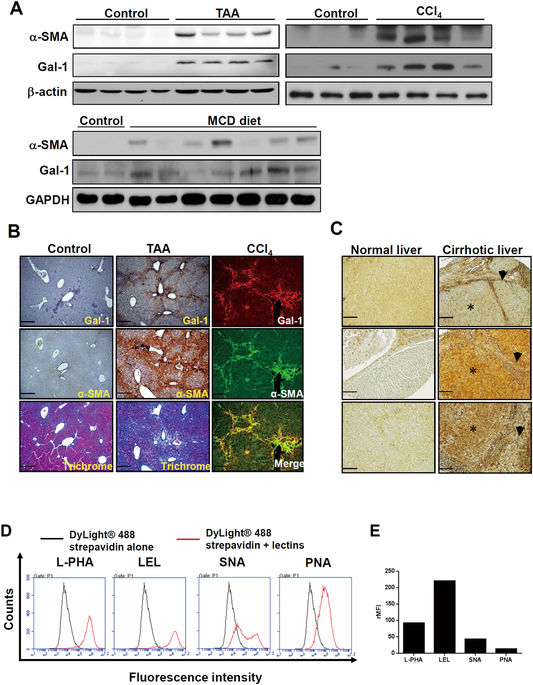Our official English website, www.x-mol.net, welcomes your
feedback! (Note: you will need to create a separate account there.)
Glycosylation-dependent galectin-1/neuropilin-1 interactions promote liver fibrosis through activation of TGF-β- and PDGF-like signals in hepatic stellate cells.
Scientific Reports ( IF 3.8 ) Pub Date : 2017-Sep-08 , DOI: 10.1038/s41598-017-11212-1 Ming-Heng Wu , Yuh-Ling Chen , Kuen-Haur Lee , Che-Chang Chang , Tsai-Mu Cheng , Szu-Yuan Wu , Chao-Chiang Tu , Wan-Lin Tsui
Scientific Reports ( IF 3.8 ) Pub Date : 2017-Sep-08 , DOI: 10.1038/s41598-017-11212-1 Ming-Heng Wu , Yuh-Ling Chen , Kuen-Haur Lee , Che-Chang Chang , Tsai-Mu Cheng , Szu-Yuan Wu , Chao-Chiang Tu , Wan-Lin Tsui

|
Concomitant expressions of glycan-binding proteins and their bound glycans regulate many pathophysiologic processes, but this issue has not been addressed in liver fibrosis. Activation of hepatic stellate cells (HSCs) is a rate-limiting step in liver fibrosis and is an important target for liver fibrosis therapy. We previously reported that galectin (Gal)-1, a β-galactoside-binding protein, regulates myofibroblast homeostasis in oral carcinoma and wound healing, but the role of Gal-1 in HSC migration and activation is unclear. Herein, we report that Gal-1 and its bound glycans were highly expressed in fibrotic livers and activated HSCs. The cell-surface glycome of activated HSCs facilitated Gal-1 binding, which upon recognition of the N-glycans on neuropilin (NRP)-1, activated platelet-derived growth factor (PDGF)- and transforming growth factor (TGF)-β-like signals to promote HSC migration and activation. In addition, blocking endogenous Gal-1 expression suppressed PDGF- and TGF-β1-induced signaling, migration, and gene expression in HSCs. Methionine and choline-deficient diet (MCD)-induced collagen deposition and HSC activation were attenuated in Gal-1-null mice compared to wild-type mice. In summary, we concluded that glycosylation-dependent Gal-1/NRP-1 interactions activate TGF-β and PDGF-like signaling to promote the migration and activation of HSCs. Therefore, targeting Gal-1/NRP-1 interactions could be developed into liver fibrosis therapy.
中文翻译:

糖基化依赖性半乳糖凝集素-1 /神经纤维蛋白-1相互作用通过激活肝星状细胞中的TGF-β-和PDGF-样信号促进肝纤维化。
聚糖结合蛋白及其结合的聚糖的伴随表达调节许多病理生理过程,但是在肝纤维化中尚未解决该问题。肝星状细胞(HSC)的激活是肝纤维化的限速步骤,并且是肝纤维化治疗的重要目标。我们先前曾报道过半乳糖凝集素(Gal)-1,一种β-半乳糖苷结合蛋白,在口腔癌和伤口愈合中调节肌纤维母细胞稳态,但尚不清楚Gal-1在HSC迁移和激活中的作用。在本文中,我们报道Gal-1及其结合的聚糖在纤维化肝脏和活化的HSC中高度表达。活化的HSC的细胞表面糖原促进了Gal-1结合,这在识别神经毛蛋白(NRP)-1上的N-聚糖后,激活血小板衍生生长因子(PDGF)和转化生长因子(TGF)-β样信号来促进HSC迁移和激活。另外,阻断内源性Gal-1表达抑制了HSC中PDGF-和TGF-β1诱导的信号传导,迁移和基因表达。与野生型小鼠相比,Gal-1-null小鼠的蛋氨酸和胆碱缺乏饮食(MCD)诱导的胶原沉积和HSC激活减弱。总之,我们得出的结论是,糖基化依赖性的Gal-1 / NRP-1相互作用激活TGF-β和PDGF样信号传导,从而促进HSC的迁移和激活。因此,靶向Gal-1 / NRP-1相互作用可以发展为肝纤维化治疗。HSC中的迁移和基因表达。与野生型小鼠相比,Gal-1-null小鼠的蛋氨酸和胆碱缺乏饮食(MCD)诱导的胶原蛋白沉积和HSC激活减弱。总之,我们得出的结论是,糖基化依赖性的Gal-1 / NRP-1相互作用激活TGF-β和PDGF样信号传导,从而促进HSC的迁移和激活。因此,靶向Gal-1 / NRP-1相互作用可以发展为肝纤维化治疗。HSC中的迁移和基因表达。与野生型小鼠相比,Gal-1-null小鼠的蛋氨酸和胆碱缺乏饮食(MCD)诱导的胶原蛋白沉积和HSC激活减弱。总之,我们得出的结论是,糖基化依赖性的Gal-1 / NRP-1相互作用激活TGF-β和PDGF样信号传导,从而促进HSC的迁移和激活。因此,靶向Gal-1 / NRP-1相互作用可以发展为肝纤维化治疗。
更新日期:2017-09-08
中文翻译:

糖基化依赖性半乳糖凝集素-1 /神经纤维蛋白-1相互作用通过激活肝星状细胞中的TGF-β-和PDGF-样信号促进肝纤维化。
聚糖结合蛋白及其结合的聚糖的伴随表达调节许多病理生理过程,但是在肝纤维化中尚未解决该问题。肝星状细胞(HSC)的激活是肝纤维化的限速步骤,并且是肝纤维化治疗的重要目标。我们先前曾报道过半乳糖凝集素(Gal)-1,一种β-半乳糖苷结合蛋白,在口腔癌和伤口愈合中调节肌纤维母细胞稳态,但尚不清楚Gal-1在HSC迁移和激活中的作用。在本文中,我们报道Gal-1及其结合的聚糖在纤维化肝脏和活化的HSC中高度表达。活化的HSC的细胞表面糖原促进了Gal-1结合,这在识别神经毛蛋白(NRP)-1上的N-聚糖后,激活血小板衍生生长因子(PDGF)和转化生长因子(TGF)-β样信号来促进HSC迁移和激活。另外,阻断内源性Gal-1表达抑制了HSC中PDGF-和TGF-β1诱导的信号传导,迁移和基因表达。与野生型小鼠相比,Gal-1-null小鼠的蛋氨酸和胆碱缺乏饮食(MCD)诱导的胶原沉积和HSC激活减弱。总之,我们得出的结论是,糖基化依赖性的Gal-1 / NRP-1相互作用激活TGF-β和PDGF样信号传导,从而促进HSC的迁移和激活。因此,靶向Gal-1 / NRP-1相互作用可以发展为肝纤维化治疗。HSC中的迁移和基因表达。与野生型小鼠相比,Gal-1-null小鼠的蛋氨酸和胆碱缺乏饮食(MCD)诱导的胶原蛋白沉积和HSC激活减弱。总之,我们得出的结论是,糖基化依赖性的Gal-1 / NRP-1相互作用激活TGF-β和PDGF样信号传导,从而促进HSC的迁移和激活。因此,靶向Gal-1 / NRP-1相互作用可以发展为肝纤维化治疗。HSC中的迁移和基因表达。与野生型小鼠相比,Gal-1-null小鼠的蛋氨酸和胆碱缺乏饮食(MCD)诱导的胶原蛋白沉积和HSC激活减弱。总之,我们得出的结论是,糖基化依赖性的Gal-1 / NRP-1相互作用激活TGF-β和PDGF样信号传导,从而促进HSC的迁移和激活。因此,靶向Gal-1 / NRP-1相互作用可以发展为肝纤维化治疗。





















































 京公网安备 11010802027423号
京公网安备 11010802027423号